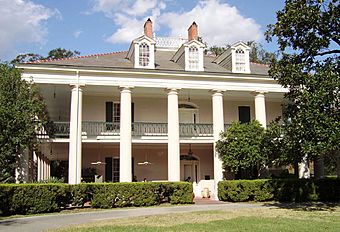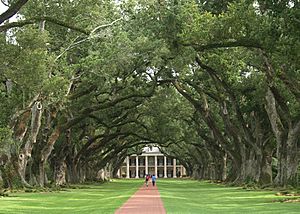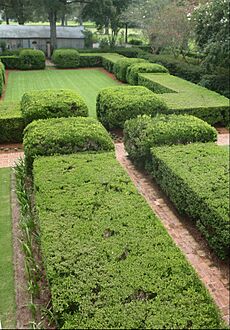Oak Alley Plantation facts for kids
|
Oak Alley Plantation
|
|

Oak Alley Plantation mansion
|
|
| Lua error in Module:Location_map at line 420: attempt to index field 'wikibase' (a nil value). | |
| Nearest city | Vacherie, Louisiana, U.S. |
|---|---|
| Area | 25 acres (10 ha) |
| Built | 1839 |
| Architect | Joseph Pilié |
| Architectural style | Greek Revival |
| NRHP reference No. | 74002187 |
Quick facts for kids Significant dates |
|
| Added to NRHP | December 2, 1974 |
| Designated NHL | December 2, 1974 |
Oak Alley Plantation is a famous historic plantation located in Vacherie, Louisiana, right on the west bank of the Mississippi River. It's known for its amazing feature: a long path, about 800 feet (240 meters) long, made by two rows of huge southern live oak trees. These trees were planted way back in the early 1700s, long before the main house was even built!
The name "Oak Alley" comes from this beautiful tree-lined path, which runs from the house all the way to the river. This special place is recognized as a National Historic Landmark because of its unique architecture, beautiful landscaping, and an important discovery made there. An enslaved gardener successfully grew a new type of pecan tree in 1846–47.
Contents
History of Oak Alley Plantation
The Roman Family and Early Days
The plantation was first called Bon Séjour. It was started in 1830 by Valcour Aime, who was known as the "King of Sugar" because he was very wealthy from growing sugarcane. In 1836, Valcour Aime traded this land with his brother-in-law, Jacques Telesphore Roman.
The very next year, in 1837, enslaved people working for Jacques Roman began building the grand mansion you see today. It was finished in 1839. Jacques Roman's father-in-law, Joseph Pilié, was an architect, and he likely designed the beautiful house.
The Amazing Pecan Tree Discovery
An enslaved gardener named Antoine, who worked at Oak Alley, was very skilled at grafting plants. Grafting is when you join parts of two plants so they grow as one. After many tries, in the winter of 1846, Antoine successfully created a new kind of pecan! This pecan was special because its shell was so thin you could crack it with just your hands. People called it the 'paper shell' pecan.
This new pecan variety later won a prize at a big competition in Philadelphia in 1876 and was named the Centennial Variety. Even though Antoine's original trees were later removed to make more room for sugarcane, his special pecans spread throughout southern Louisiana.
Jacques Roman passed away in 1848. His wife, Celina Pilié Roman, then managed the plantation. However, she wasn't very good at running a sugar plantation and spent a lot of money, which almost caused the family to lose the estate. In 1859, her son, Henri, took over and tried to fix things.
The American Civil War (1861-1865) didn't physically damage the plantation, but it changed everything. After the war, slavery ended, and it became very difficult to make money from the plantation. Henri ended up deeply in debt. In 1866, his uncle and sisters had to sell the plantation at an auction.
The Stewart Family and Restoration
After the Roman family, several different owners tried to keep Oak Alley going, but it was very expensive. By the 1920s, the buildings were in bad shape.
In 1925, Andrew Stewart bought the property as a special gift for his wife, Josephine. Josephine loved the place and hired an architect named Richard Koch to help restore the house. They worked hard to fix it up and add modern comforts.
At that time, a plant disease had hurt the sugarcane industry. So, the Stewarts decided to run Oak Alley Plantation as a cattle ranch instead, since Josephine had grown up on a ranch in Texas. Later, in the 1960s, sugarcane farming was brought back to the plantation.
The Stewarts were the last family to live at Oak Alley. When Josephine Stewart passed away in 1972, she left the historic house and grounds to the Oak Alley Foundation. This foundation then opened the plantation to the public, so everyone could visit and learn about its history.
Mansion and Grounds
Architecture of the Mansion
The main house at Oak Alley is built in the Greek Revival architecture style. This means it looks a bit like ancient Greek temples, with grand columns. The house has a square shape, with a wide hall running through the middle on both floors. The rooms have tall ceilings and big windows.
Outside, there are 28 large Doric columns all around the house. These columns match the 28 oak trees in the famous alley! Many old mansions in the Mississippi River Valley have these beautiful oak trees.
The walls of the mansion are 16 inches (41 cm) thick and made of bricks that were created right there on the plantation. The outside of the walls is covered with stucco and painted white to look like marble. The roof is made of slate.
When the Stewarts restored the house in the 1920s, they made some changes. They moved the staircase to the central hall and replaced the marble floors with wood.
Exploring the Grounds
The grounds around the mansion are also beautiful. Josephine Stewart created a lovely formal garden that separates the house from the old garage. This old garage now hosts the Sugarcane Theater, where visitors can watch a video and see exhibits about the history of growing sugarcane.
You can also find a blacksmith shop on the grounds, where a blacksmith would have worked long ago. There's also the Stewart family graveyard.
See also
- St. Joseph Plantation: a plantation located next to Oak Alley
- List of plantations in Louisiana
- List of National Historic Landmarks in Louisiana
- National Register of Historic Places listings in St. James Parish, Louisiana





